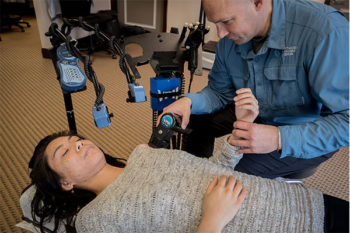Laser Mechanisms of Action in Oakland, CA
Optimized Wellness Center • (510) 497-4424 or Email Us
Laser Mechanisms of Action in Oakland, CA
 Laser therapy, or “photobiomodulation”, has been used effectively and safely for decades now. Not only that, but there are over 4000 studies that have been performed and published with positive outcomes from using photobiomodulation. There are more than a dozen FDA approvals for this therapy and has been used for 40 years in a medical setting. Below we will briefly describe the mechanisms involved that have been demonstrated through published research:
Laser therapy, or “photobiomodulation”, has been used effectively and safely for decades now. Not only that, but there are over 4000 studies that have been performed and published with positive outcomes from using photobiomodulation. There are more than a dozen FDA approvals for this therapy and has been used for 40 years in a medical setting. Below we will briefly describe the mechanisms involved that have been demonstrated through published research:
- Enhancement of ATP production and synthesis
* ATP production and synthesis are significantly enhanced, contributing to cellular repair, reproduction and functional ability
* Photonic stimulation of Cytochrome c Oxidase, a chromophore found on the mitochondria of cells, plays a major role in this rapid increase in production and synthesis of ATP.
- Stabilization of the cellular membrane
* Ca++, Na+ and K+ concentrations, as well as the proton gradient over the mitochondria membrane are positively influenced.
* This is accomplished in part, by the production of beneficial Reactive Oxygen Species aka (ROS).
* These ROS’s modulate intracellular Ca++ concentrations and laser therapy improves Ca++ uptake in the mitochondria.
- Stimulation of vasodilation
* Vasodilation is stimulated via an increase in Histamine, Nitric Oxide (NO) and Serotonin levels, resulting in reduction of ischemia and improved perfusion
* Laser-mediated vasodilation enhances the transport of nutrients and oxygen to the damaged cells and facilitates repair and removal of cellular debris.
- Acceleration of leukocytic activity
* Beneficial acceleration of leukocytic activity, resulting in enhanced removal of non-viable cellular and tissue components.
* Thus, allowing for a more rapid repair and regeneration process.
- Increased prostaglandin synthesis
* Prostaglandins have a vasodilating and anti-inflammatory action
- Reduction in interleukin 1
* Laser irradiation has a reducing effect on this pro-inflammatory cytokine that has been implicated in the pathogenesis of rheumatoid arthritis and other inflammatory conditions.
- Enhanced lymphocyte response
* In addition to increasing the number of lymphocytes, laser irradiation mediates the action of both lymphatic helper T-cells and suppressor T-cells in the inflammatory response.
* Along with laser modification of beta cell activity, the entire lymphatic response is beneficially affected by laser therapy.
- Increased angiogenesis
* Both blood capillaries and lymphatic capillaries have been clinically documented to undergo significant increase and regeneration in the presence of laser irradiation.
- Temperature modulation
* Areas of inflammation typically demonstrate temperature variations, with the inflamed portion having an elevated temperature.
* Laser therapy has been shown to accelerate temperature normalization, demonstrating a beneficial influence on the inflammatory process.
- Enhanced superoxide dismutase (SOD) levels
* Laser stimulated increases in cytokine SOD levels interact with other anti-inflammatory processes to accelerate the termination of the inflammatory process.
- Decreased C-reactive protein and neopterin levels
* Laser therapy has been shown to lower the serum levels of these inflammation markers, particularly in rheumatoid arthritis patients
- Increase in beta endorphins
* The localized and systemic increase of this endogenous peptide, after laser therapy irradiation has been clinically reported in multiple studies, to promote pain reduction.
- Increased nitric oxide production
* Nitric oxide has both a direct and indirect impact on pain sensation. As a neurotransmitter, it is essential for normal nerve cell action potential in impulse transmission activity.
* And indirectly, the vasodilation effect of nitric oxide can enhance nerve cell perfusion and oxygenation.
- Decreased bradykinin levels
* Since Bradykinins elicit pain by stimulating nociceptive afferents in the skin and viscera, mitigation of elevated levels through laser therapy can result in pain reduction.
- Ion channel normalization
* Photobiomodulation promotes normalization in Ca++, NA+ and K+ concentrations, resulting in pain reduction because of these ion concentration shifts.
- Blocked depolarization of C-fiber afferent nerves
* The pain blocking effect of therapeutic lasers can be pronounced, particularly in low velocity neural pathways, such as non-myelinated afferent axons from nociceptors.
* Laser irradiation suppresses the excitation of these fibers in the afferent sensory pathway.
- Increased nerve cell action potentials
* Healthy nerve cells tend to operate at about -70 mV, and fire at about -20 mV. Compromised cell membranes have a lowered threshold as their resting potentials average around this -20 mV range.
* That means that normal non-noxious activities produce pain.
* Laser therapy can help restore the action potential closer to the normal -70 mV range.
- Increased release of acetylcholine
* By increasing the available acetylcholine, Laser Therapy helps in normalizing nerve signal transmission in the autonomic, somatic and sensory neural pathways.
- Axonal sprouting and nerve cell regeneration
* Several studies have documented the ability of laser therapy to induce axonal sprouting and some nerve regeneration in damaged nerve tissues.
* Where pain sensation is being magnified due to nerve structure damage, cell regeneration and sprouting may assist in reducing pain.

